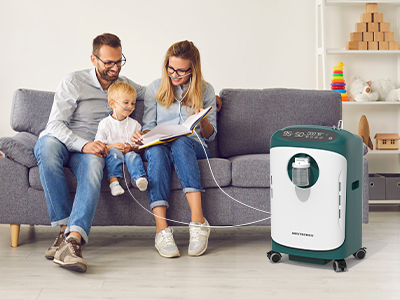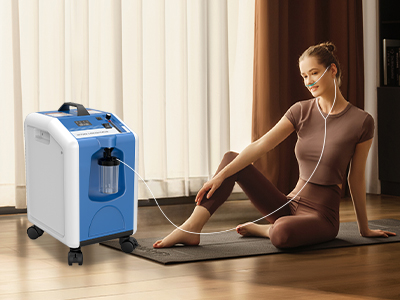22 Nov 2024
The importance of oxygen for life is undeniable, yet for many individuals, breathing freely is a struggle. Home oxygen therapyoffers a lifeline to those with chronic respiratory conditions or low oxygen levels. By understanding the steps involved, patients and caregivers can confidently navigate the process, ensuring timely access to this vital treatment.

Step 1: Understanding the Need for Oxygen Therapy
Home oxygen therapy is often prescribed for individuals whose oxygen levels are insufficient to support vital bodily functions. Conditions like chronic obstructive pulmonary disease (COPD), pulmonary fibrosis, and severe asthma are common culprits. Additionally, heart failure and certain neuromuscular disorders may also impair oxygen delivery throughout the body.
Symptoms such as persistent breathlessness, chronic fatigue, and confusion can signal the need for oxygen therapy. Left unaddressed, low oxygen levels, or hypoxemia, can cause organ damage and significantly diminish quality of life. Recognizing these early warning signs is the first step toward receiving help.
Step 2: Consulting with a Healthcare Provider
The journey to qualifying for home oxygen therapy begins with a conversation. Patients experiencing symptoms indicative of low oxygen levels should consult their primary care physician or a pulmonologist. During this consultation, the healthcare provider will conduct a thorough medical history review and physical examination.
This step is critical not only to confirm the necessity of oxygen therapy but also to rule out alternative causes of symptoms. A trusted medical professional can guide patients through the process, ensuring no step is overlooked.

Step 3: Undergoing Necessary Testing
Accurate testing is central to determining a patient's eligibility for oxygen therapy. Two primary methods are employed: arterial blood gas (ABG) analysis and pulse oximetry.
ABG testing involves drawing blood from an artery to measure oxygen, carbon dioxide, and pH levels. While more invasive, it provides precise data on the body's respiratory efficiency. Pulse oximetry, on the other hand, is a non-invasive method using a small device clipped to the fingertip. It measures oxygen saturation in the blood and offers a quick snapshot of a patient’s oxygen status.
These test results are compared against established thresholds. For example, a blood oxygen saturation level below 88% or an arterial oxygen partial pressure (PaO2) below 55 mmHg often qualifies a patient for home oxygen therapy. Proper documentation of these findings is essential for insurance and medical compliance.
Step 4: Insurance and Financial Considerations
Qualifying for oxygen therapy involves more than just medical approval; financial aspects must also be addressed. Many insurance providers, including Medicare and Medicaid, require specific documentation to approve coverage for oxygen equipment and therapy. This documentation typically includes diagnostic test results and a prescription from a licensed healthcare provider.
For individuals without comprehensive insurance coverage, the cost of oxygen therapy can seem daunting. However, financial assistance programs, nonprofit organizations, and local health agencies often provide support. Patients should explore these resources to minimize out-of-pocket expenses.
Step 5: Obtaining a Prescription and Selecting Equipment
A prescription is the key to accessing oxygen therapy. This document specifies the flow rate (measured in liters per minute) and duration of therapy, tailored to the patient’s specific medical needs. Once the prescription is in hand, the next step is selecting appropriate equipment.
Oxygen concentrators, compressed oxygen tanks, and liquid oxygen systems are the most common delivery methods. Each option has unique advantages and limitations. For example, portable oxygen concentrators are ideal for active individuals, while stationary concentrators are suited for home use. Selecting the right device ensures effective therapy and aligns with the patient’s lifestyle.
Preparing for Oxygen Therapy at Home
Setting up for home oxygen therapy involves more than plugging in a device. The patient’s environment must be optimized for safety and convenience. This includes identifying a secure location for the equipment, away from open flames or heat sources, and ensuring access to backup power during outages.
Patients and caregivers should also be educated on proper equipment maintenance and oxygen safety protocols. For instance, understanding how to clean tubing, replace filters, and handle oxygen tanks prevents malfunctions and extends the lifespan of the device.
The Role of Follow-Up Care and Monitoring
Oxygen therapy is not a one-and-done solution; it requires ongoing management. Regular follow-up appointments with a healthcare provider are essential to monitor the therapy's effectiveness and make necessary adjustments. Changes in oxygen needs may occur due to disease progression or improvements in health.
Moreover, periodic retesting ensures that patients remain eligible for therapy under insurance guidelines. These visits also provide an opportunity for patients to discuss any concerns or challenges they may be facing.
Common Challenges and How to Overcome Them
Adapting to oxygen therapy can be challenging for some patients. Issues such as the stigma of using oxygen devices in public or fear of dependency often arise. Education and support play a pivotal role in addressing these concerns.
Encouraging patients to focus on the benefits—such as improved energy levels and enhanced quality of life—can help them overcome initial hesitations. Support groups and community resources can also provide reassurance and practical advice.
Conclusion
Home oxygen therapy is a transformative treatment for individuals with chronic respiratory conditions. By following these five steps—understanding the need, consulting a healthcare provider, undergoing testing, addressing financial considerations, and obtaining the necessary prescription—patients can gain access to life-enhancing care. With proper preparation, education, and ongoing support, oxygen therapy becomes not just a treatment but a means of reclaiming independence and vitality.
Keywords: oxygen therapy
Originally published 22 Nov 2024, updated 22 Nov 2024.